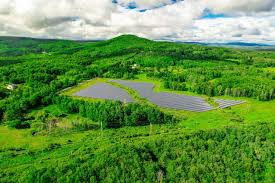Menu
Just Transition Insights, Issue #10, 02/27/2023
By Jonathan Tasini
|

Leading Off: Canada’s “Sustainable Jobs Plan”
Over the past several years, Canada has had a fairly active debate about Just Transition for workers, and communities. For example, in 2018, a national taskforce produced this report outlining steps to be taken and, crucially, noting the process:
…will need to invest considerably more funding, potentially in the hundreds of millions of dollars, through Budget
2019 and subsequent budgets to implement our recommendations.i It would be prudent for the Government
to reprioritize and reallocate existing funding, as much as possible, including from infrastructure funds, so
that decisions reflect the views of affected communities and workers.
The problem is that there was a large gap in all the efforts between good intentions and specific, hard commitments of money for Just Transition.
Into this space lands a new report from the government: Sustainable Jobs Plan.
Some specifics on money allocations are detailed:
Recognizing the importance of helping Canadians access the job training they want, the Government has made historic investments in skills programming, including for sustainable jobs. Access to these opportunities for young people, people with disabilities, and people from historically marginalized communities is paramount to improving equity and diversity, ensuring inclusive prosperity.Footnote 12 Such investments include:
- $960 million over 3 years to the Sectoral Workforce Solutions Program, to help key economic sectors, including sectors contributing to the low-carbon economy, implement solutions to address current and emerging workforce needs, such as connecting workers with the training they need to access good jobs and help employers attract and retain a skilled a diverse workforce.
- $55 million over 2 years to the Community Workforce Development Program, to help communities develop local workforce plans that identify high growth areas and connect employers and training providers to upskill and reskill jobseekers and workers to fill emerging jobs.
- $25 million annually – as well as additional investments under the 2022 Fall Economic Statement – to the Union Training and Innovation Program, to support union-based apprenticeship training, innovation and enhanced partnerships in the Red Seal trades.
- The Skills Partnership Fund, a project-based fund that supports partnerships between Indigenous organizations and industry employers to provide skills training for Indigenous Peoples.
- $272 million over 5 years, for the Opportunities Fund for Persons with Disabilities, which assists persons with disabilities to prepare for, obtain and maintain employment. It supports persons with disabilities in overcoming barriers to participation in the Canadian labour market, and it supports employers to hire persons with disabilities. The Government of Canada is investing to ensure that people with disabilities are not disproportionately excluded from the opportunities associated with market transformation.Footnote 13
- $250 million over 3 years for the Upskilling for Industry Initiative to scale up proven industry-led, third-party delivered approaches to upskilling and redeploying workers across high-growth sectors, including clean technologies.
In addition, Canada has a strong income-support system, including employment insurance (EI). Temporary measures announced in Budget 2021 helped facilitate greater access to a more simplified EI program for Canadians during the pandemic and subsequent waves of unemployment. In summer 2022, Canada concluded its two-year consultations with workers, employers and academics on the design of a modernized EI program that better meets the current and future needs of workers and employers. A comprehensive plan for the future of the EI program is being developed that incorporates results from these consultations and lessons learned from the pandemic.
We wonder, however, whether the investment in skills and retraining *absent* an analysis of why previous schemes on retraining have fallen short will mean that the money
Pushing through this plan will fall principally to two bodies:
Establish the Sustainable Jobs Secretariat
The 2022 Fall Economic Statement proposed providing $250 million over five years to Employment and Social Development Canada to help ensure Canadian workers can thrive in a changing global economy. This funding will be directed towards a Sustainable Jobs Secretariat, a new sustainable jobs stream under the Union Training and Innovation Program, as well as a Sustainable Jobs Training Centre.
The development of a central and expert-driven governance structure was among the most important best practices from other jurisdictions and recommendations made throughout the public consultations. Establishing a Sustainable Jobs Secretariat will provide leadership and allow for a whole-of-Government approach on sustainable jobs measures. It will also ensure coordination of federal policies and programs among Government departments, and implementation of forthcoming Sustainable Jobs Action Plans.
As announced in the 2022 Fall Economic Statement, the Secretariat will offer a one-stop shop for workers and employers and provide the most up to date information on federal programs, funding, and services across government departments. Furthermore, it will enable critical engagement, including with provinces and territories, as Sustainable Jobs Action Plans are developed.
Further details of the Sustainable Jobs Secretariat will be released in 2023.
2. Create a Sustainable Jobs Partnership Council
A key pillar of supporting an inclusive and equitable future includes ensuring workers and their communities are empowered on decisions that affect their future. Social dialogue – bringing together government, workers, and industry through sustained dialogue, along with other key partners and stakeholders – promotes policy coherence to ensure that climate action also results in job creation and community prosperity.
To support this engagement, the proposed sustainable jobs legislation will establish a permanent Sustainable Jobs Partnership Council, previously referred to as an “Advisory Body”. Reflecting feedback received during consultations, the Council will involve a ‘tripartite-plus’ governance approach based on social dialogue between governments, employers and labour, with additional consultation that includes relevant and affected stakeholders, such as civil society and trade associations. The Partnership Council would also undertake engagement with stakeholders and partners across all regions of Canada, including rural and remote communities, in order to provide its advice. Further details on this organization will be provided in 2023. The Council would have opportunities to provide meaningful input to inform the policy and program development process, similar to how the Net-Zero Advisory Body provides advice to the Minister of Environment and Climate Change with respect to achieving net-zero emissions by 2050.
The Council will be a driving force in ensuring the government’s actions equip Canadian workers to thrive in a net-zero emissions economy, and will undertake robust engagement with Canadians, producing annual advice to Government and working in collaboration with other relevant entities such as the Net-Zero Advisory Body. The Council would be established following Royal Assent of the Sustainable Jobs legislation.
The Council will have 2 core functions:
-
Provide independent and ongoing advice to Government on the most effective measures to encourage the creation of sustainable jobs and to support workers and communities in the transition to a net-zero economy. The Council will regularly meet with government officials and will submit an annual report to the lead minister.
-
Conduct sustained engagement with workers, unions, industry and Canadians more broadly as part of the social dialogue underpinning the Government’s sustainable jobs approach across all regions of Canada. This engagement will inform the Council’s advice and promote cooperation on sustainable jobs through consultations and an exchange of information between the Council and those implicated, such as workers, communities, and industry, essential components of a social dialogue.
The “Secretariat” echos a bit of the flavor of the emerging Australian framework that could include an authority for Just Transition. We will keep looking at the Canada plan as it gets set up—and analyze whether the principles laid out in the plan, and, perhaps, more important, the money promised, actually create a “high bar” Just Transition.
SPONSOR MESSAGE
A message from the Australian Mining And Energy Union
We are fighting back, not just for ourselves but for the future generation of mineworkers. Workers deserve better. Our families and communities deserve better. Visit us
Spotlight: “Green Banks” Don’t See Workers
Quite the rage on financing climate change are a passel of “green” banks popping up. This is a fairly accurate description of “green” banks:
Green banks provide financing to support climate-friendly projects, often focusing on energy savings and solar generation in residential and commercial buildings. Such projects have struggled to obtain capital from traditional financing institutions.
Like conventional banks, green banks provide loans that must be repaid, but they often offer long-term, low-interest loans that aren’t available on the private market. Some use other tools to lower risk for private lenders or to finance projects in partnership with utilities.
Green banks can be public, quasi-public or nonprofit institutions. Several green banks have been established by state lawmakers, governors or agencies, often with some level of state funding. Many state-level green banks have focused much of their work in low- to moderate-income communities, which have the greatest need for energy upgrades and the least access to financing.
There is even a “Coalition for Green Capital” which has a “case” for a “national climate bank” all laid out.
The Connecticut Green Bank, name-checking the Pope, has a glossy report outlining “Inclusive Prosperity and the Green Economy“ and reports:
In its first five years, the Connecticut Green Bank has invested $200 million of public funds to mobilize over $1.2 billion of investment into Connecticut’s green energy economy. This investment has reduced the burden of energy costs on nearly 27,000 families and businesses, created over 14,000 jobs in our communities, raised over $50 million in sales, individual, and corporate tax revenues for Connecticut…
In addition, the Connecticut Green Bank promises such “Investment Leads to Economic Growth—Creating Meaningful Jobs in Our Communities“:
Solar photovoltaic installers and wind turbine service technicians are projected to be the first – and second – fastest growing occupations from 2016 through 2026 in the United States – +105% and +96%, respectively. Alongside the growth in jobs in the green economy, there will need to be simultaneous efforts for a just transition for certain parts of the country or sectors of the market. For example, displaced coal miners in Wyoming and West Virginia – states with the largest share of these workers – will need workforce development and training. The growth of customers using Uber and Lyft, as opposed to taxi cabs, and the onset of autonomous vehicles, will require that assistance be provided to cab drivers and employees of automobile manufacturers...The more we increase investment in green energy, the more efforts that will be required for a just transition for those jobs displaced by the economic dislocation from the green economy.
The problem with all “green” banks is that, to our knowledge, none of the banks criteria for lending to projects requires that the jobs created are high-wage jobs and equal the incomes and benefits being lost. Indeed, name-checking Uber and Lyft—two of the most anti-union companies in the transportation sector—should be a red flag.
It would behoove the climate change activist world—here is an example—touting “green” banks to consider folding into plans for such investment vehicles a requirement that every job promised have a “high bar” standard.
We would appreciate examples of “green banks” that are taking workers’ rights into account and we promise to highlight such genuine efforts.
Ideas: We Need A Global Deep-Dive On ReTraining
We’ve been critical of the enormous amount of money going into retraining because the results are quite underwhelming—meaning, looking at the actual prospects facing displaced workers and the kinds of wages offered in the jobs on offer. This isn’t just a problem raised by climate change—retraining and reskilling efforts going back decades have produced mediocre outcomes.
As yours truly explained in this 2021 study:
A central fallacy of the entire retraining philosophy is its heavy reliance on the notion that education is key to a successful next job chapter. This is false: the overriding factor in jobs today is based not on competition over skills but competition based on wages. No matter how smart a person is, there will always be someone who will do a job for less if there is no minimum standard – minimum standards set by unions or, at the very least, a livable federal minimum wage. So, education, which in the abstract is not objectionable, is the wrong answer to the question of how people will have any kind of economic stability.
It’s also true that most retraining programs are ill-conceived because (a) they don’t start at the workplace while a worker is still employed and, related, (b) the programs are under-funded in terms of what it would take to make it financially possible for a worker to participate (for example, paying for child care costs)
To get to the bottom of this problem, it would be worth considering a global, honest, inquiry into the track record of retraining and reskilling programs. The inquiry would look at the real outcomes for workers over a long period of time. We can suggest a set of metrics for the inquiry but, at the end, a program could only be deemed a success if a worker landed in a job with equal pay and benefits to a job lost.
Opinion: Job Sustainability, Equity, Diversification and Transitions in South Africa
By Melanie Roy
For the first time since in the convening of the various Mining Indabas, this year, Industry had acknowledged the imperative role of Labour and their input in the Indaba. Hence, Labour, including NUMSA [National Union of Metalworkers of South Africa] as part of the Industriall Global Union representation, were speakers at the Mining Indaba 2023, as well as at the Alternative mining indaba at the University of Capetown with academic researchers from all over the world. The focus: “Africa amidst the Energy transitions and opportunity.”
The Energy indaba’s primary focus was unlocking Investment and Technological advancements within the Mining and associated industries. But, our views as Labour focused on job sustainability, equity, diversification and transitions based on a pace and cost affordable for the workers and the country to make such transitions—concepts that have always been NUMSA’s core position.
The core views of Labour focus was bringing workers on board in the technological change, considering the future of mining and mobility. Trade Unions from all Sub Saharan Africa were represented in this event to guide industry into a good transition plan that benefits workers and society at large.
Overall, particularly in the coal sector, trade unions were pushing for a comprehensive approach to job security and job retention that involves anticipation, mapping and planning. We put firmly on the table in dialogue with mining companies, for example, the retention of the highly qualified workforce, negotiation of transition agreements. We also looked at issues beyond climate change and the drivers of the impacts on the world of work in the current transition underway and Trade Union proposals for a mitigation pathway, amongst others.
The other urgent questions raised were in terms of where are the future ‘green’ jobs and what were the prospects for such jobs in the low carbon energy transition (for example, renewable energy solar, wind, battery storage, and hydrogen), as well as who will be occupying these jobs, and whether these jobs will be jobs be decent and sustainable. Conversations also included Botswana which has joined with Canadians towards sustainable mining initiatives, taking into account other forms of informal mining as well.
The core of the conversation was centered around on what the deepest and fundamental concerns of workers are in relation to the transition to a low carbon energy future and to what extent Just Transition dialogue takes place in the operations between all stakeholders (workers, trade unions and companies, both on a Global and local perspective) and what the demands for a just transition were. Labour articulated its various positions in a unified manner of what a just transition should look like.
These were some of the highlights that were emphasised in the conversations.
The response to climate change brings its own challenges arising out of technological innovations, throwing, therefore, a curve ball beyond climate change that determines the future world of work consistent with low carbon energy transition to which workers must adapt. To mitigate these impacts, both the ILO Guidelines and the Paris Agreement highlight the imperatives of a just transition and the creation of decent work as essential dimensions of climate change. More than anyone else, mineworkers know how unsettling and disruptive changes to the world of work can be because they are at the coal face (no pun intended) of these impacts. As workers navigate these impacts, they must consistently remind the captains of the mining industry and governments about the ILO Declaration on Fundamental Principles and Rights at Work as an expression of commitment by governments, employers’ and workers’ organizations to uphold basic human values and as foundational principles for decent work.
Roy is the Research Manager of the Economic Research & Policy Institute at NUMSA
Links
National Union of Mineworkers (South Africa): The National Union of Mineworkers was founded in 1982.
Table of Contents
Leading Off
Canada's "Sustainable Jobs Plan"
Spotlight
"Green Banks" Don't See Workers
Ideas
We Need A Global Deep-Dive On ReTraining
Opinion
Job Sustainability, Equity, Diversification and Transitions in South Africa
Links
This Week's Links
Can’t wait to subscribe to the newsletter?
*We post information pursuant to the U.S. Fair Use Doctrine, and applicable international standards, in order to advance the knowledge base and education of our global audience. We endeavor to include the original link to documents. However, upon requests of original authors of posted documents, where explicit use permission is not granted, we will remove documents if it is determined continued use is not appropriate. We also reserve the full right to not include, or remove, any data inconsistent with our mission.

















